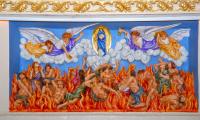Our Lady Of Lourdes Grotto

“St. Boniface Church on Wabash Avenue between Michigan and Virginia streets has long been known for its magnificent altars, its gorgeous windows and its lighting effects; but the beauty of its grotto, given in 1914 by Jacob Fischer, is comparatively little known to people of Evansville.”
That long sentence is inside quotation marks because it’s not new – although it could be. Certainly, few residents of Evansville in 2014 are aware of Our Lady of Lourdes Grotto beneath St. Boniface Church on the city’s west side. But that’s nothing new. That sentence above appeared in the Jan. 30, 1921, edition of the Evansville Journal.
About a month ago, The Message published photos and a few details about the grotto. In this issue, we offer a more in-depth look at the church, its grotto and their collective history.
Next year marks the 10th anniversary of the publication of “St. Boniface: A Living Legacy.” Retired Deacon Richard Preske compiled the history of the parish and its church for this 192-page hardbound volume, which is available for purchase from St. Boniface.
In the book, Deacon Preske reports that Bishop Silas Chatard of the Diocese of Vincennes created St. Boniface Parish on Jan. 4, 1880. He appointed Father William Bultmann as the first pastor, and a group of parishioners built a temporary church building that hosted its first Mass slightly more than a month later, on Feb. 6.
Little time passed before the parish family outgrew the building, and the permanent St. Boniface Church opened in 1882. The two towers soared 202 feet into the Evansville sky.
Sadly, it may have been one of those towers that attracted the energy from a thunderstorm cell late on Holy Saturday night in 1902 – March 29. A lightning-strike fire caused damage to the buildings and its contents estimated at $200,000; an online site called “The Inflation Calculator” reports that in today’s dollar, that would be $5.3 million.
Following is an excerpt from the history book in which Deacon Preske described the fire:
“A lightning bolt at 11:30 p.m. on Saturday night had started a tiny blaze on the corner of the roof in the rear of the church. It ate its way from back to front and finally flung a red banner from the tip of the golden cross on one of the big steeples. There, fanned by the strong wind, the fiery pennant waved defiance to the firemen and their puny streams of water on the ground beneath. Once in the church, the fire burned fiercely and was soon beyond control.
“The destruction of the immense church was one of the most spectacular sights ever witnessed, and hundreds thronged around the burning building and watched with crushed hearts as the flames reduced the beautiful edifice to a mass of ruins.”
Rebuilding began almost immediately. From the history book:
“The original walls were used, gables were added above three windows on each side and the steeples were lowered from 202 feet to 175 feet at a cost of $62,000.” That amounts to $1.64 million in today’s dollars.
Deacon Preske reports that not much historical documentation took place after the rebuild – until 1914, when the grotto was dedicated and opened. From the history book:
“Erected and donated by a pioneer and life long member of St. Boniface, Jacob Fischer, this magnificent tribute to the Mother of God for the conversion of sinners was to be the source of consolation and peace to suffering humanity. … The grotto was built for $10,000 (that’s more than $229,000 in today’s dollars) in order to allow for a peaceful quietness to Mary, the Mother of God.”
Flood waters in 1937 led to damage to the grotto’s pews and statues, forcing its closure. It reopened in 1972, but visible evidence of the flood’s impact remains.
Earlier this year, the Wargel family donated a crucifix that hangs above the entrance of the grotto. It is a tribute to family member Sister Anthony Wargel in honor of her 100th birthday.
About to enter its 101st year, the grotto is available for tours by appointment, and a group of volunteers opens it to the public every May and October – the months of Mary. For more information on the grotto or to arrange a tour, contact St. Boniface parishioner Bob Koressel at (812) 625-0035.

